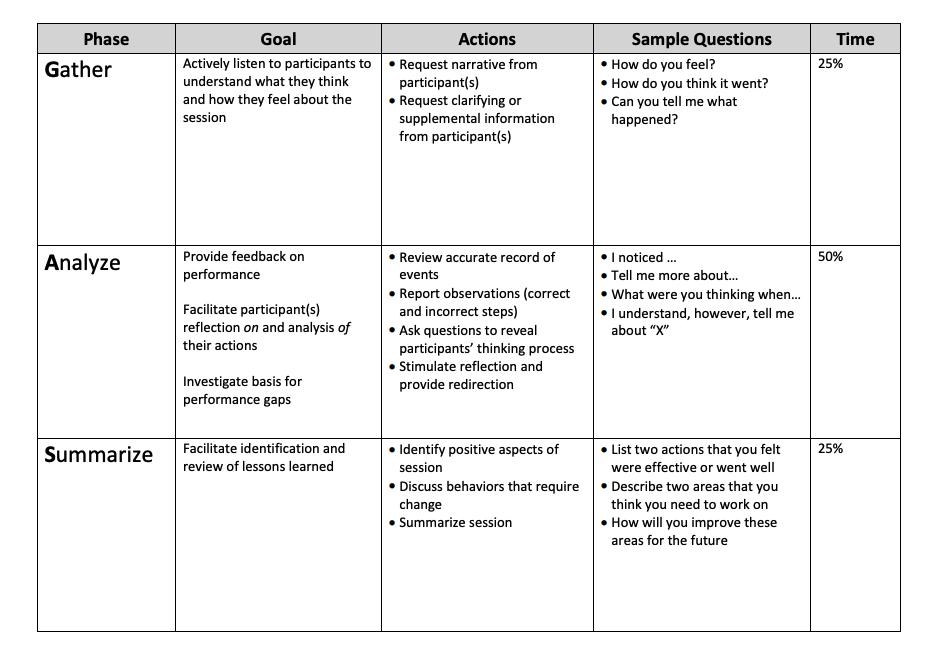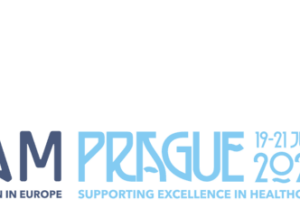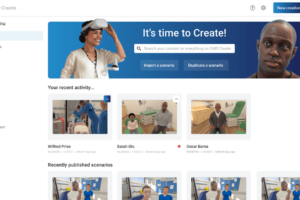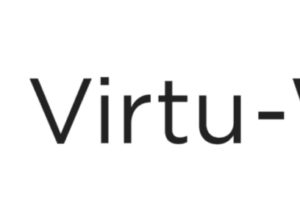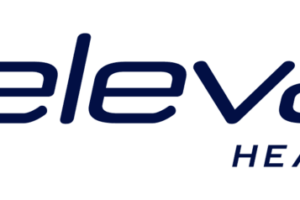Gather – Analyze – Summarize: The Simple GAS Method for Healthcare Simulation Debriefing (w/ Quick Template)
Healthcare Simulation is divided into three stages, prebriefing, simulation scenario and debriefing. Simulation links theory to practice by means of reflection, critical thinking and improved clinical practice. A variety of creative debriefing strategies may be found in the literature however, the Gather-Analyze-Summarize (GAS) tool is probably one of the easiest to understand. GAS was developed at UPMC’s WISER Simulation Center by John O’Donnell and a team of collaborators. This method allows even novice debriefers to quickly gain skill in debriefing while remaining comfortable with the process. Ideally, all debriefing faculty should receive training and practice in debriefing before they start debriefing on their own. Today we take a closer look at the G.A.S. Debriefing model.
Debriefing is often cited as the most important component of simulation since this is considered the time when learners are most likely to make changes in their thinking which, should ultimately lead to changes in future practice. During debriefing, learners consider their own frames of reference and how those references led them to act or think in a certain way. If the learner actions do not match best practice, the facilitator invites the learners to rethink their frames of reference thereby opening the way for a change in future behavior.
Successful debriefing occurs in an environment where the learner feels respected and safe. Only in this type of environment, can learners focus on their own internal thought processes and knowledge and consider changing their future responses. Research has shown that scripted debriefing improves knowledge and team leader behavior performance, when compared with non-scripted debriefing.
Sponsored Content:
Gather, Analysis, Summarize (G.A.S.) Method of Debriefing
In the research article “More Than One Way to Debrief: A Critical Review of Healthcare Simulation Debriefing Methods”, Sawyer et all explain GAS as “Another 3-phase conversational structure described includes the phases of gather, analyze, and summarize and is known as the ‘‘GAS’’ model. Using this conversational structure, the first phase (gather) encourages the team to provide a recapitulation of the simulation events to establish a shared mental model. The second phase (analyze) is dedicated to learner-centered reflection and analysis of the actions during the simulation.
During this phase, pointed questions are used to stimulate reflection and expose the learners’ thinking processes. The final phase (summary) ensures that all the important learning objectives and teaching points have been covered and provides a review of lessons learned. This debriefing conversational structure has been adopted by the American Heart Association for use during debriefing in life support courses, such as Pediatric Advanced Life Support.”
Sponsored Content:
Notes for Facilitators
- Should ask open ended questions to help steer learners to specific learning objectives while at the same time stimulating learner reflection.
- Consider team member perspectives including those of the team leader and team member perspective.
- Show respect to learners and value their input.
- Should not be overly critical.
- Report observations (both good and those not in compliance with best practice or preset standards).
- Should not start by listing all the errors learners make and ask them point blank why they made each mistake.
- Acknowledge the limitations of the simulation.
- Refocus group to scenario learning objectives if the group tends to drift away from set objectives.
- Ask questions to reveal participants thinking processes.
- Be a content expert or have another person in the room who is a content expert.
Download our GAS Debriefing Free Template Here!
Example of GAS in Practice
| Phase | Goal | Actions | Possible Scripts |
| Gather
(Listen) |
(1) Listen to participants to understand how they feel
(2) Identify what happened during the scenario |
a) Elicit participants emotional state
b) Request narrative from team leader c) Request clarifying or supplemental information form team |
To All: How do you feel?
To Team Leader: Can you tell us what happened? To Team members: Can you add to the account? |
| Analyze
(Guide Reflection) |
(1) Assure continuous focus on session objectives
(2) Facilitate participant’s reflection on & analysis of their individual actions (3) Facilitate team’s reflection on & analysis of systems issues |
a) Review of accurate record of events
b) Direct/redirect participants to assure continuous focus on session objectives c) Using Advocacy/Inquiry: d) Report observations (correct/incorrect steps) e) Ask a series of questions to reveal participants’ thinking processes f) Assist participant to reflect on their performance g) Using Plus/Delta: h) Identify systems/team issues: to reinforce the ‘+’ and consider action on the ‘Δ’ |
I noticed…
Tell me more about… How did you feel about… What were you thinking when… I understand, however, tell me about “X” aspect of the scenario Let’s refocus – “What’s important is not how its right but what is right for the patient What systems/teamwork aspects went well? What systems/teamwork aspects need improvement? |
| Summarize
(Help learners gather conclusions). |
Facilitate identification & review of lessons learned | a) Summary of comments or statements.
b) Students identify take away points |
Looking at our original objectives, what have we learned?
What will you do differently based on this experience? |
Remember the debriefer is not there to lecture but to guide the learner to reflection and change when needed. When learners themselves recognize the need to change, there is much more likelihood that learning will take place.
Further Reading: “Evolution of the Pediatric Advanced Life Support course: enhanced learning with a new debriefing tool and Web-based module for Pediatric Advanced Life Support instructors.” Adam Cheng (of Debrief2Learn) et al. redeveloped this method to help pediatric life support instructors facilitate debriefing during PALS training. The Pediatric Advanced Life Support course, first released by the American Heart Association in 1988, has seen substantial growth and change over the past few decades. Over that time, Pediatric Advanced Life Support has become the standard for resuscitation training for pediatric healthcare providers in North America.
The incorporation of high-fidelity simulation-based learning into the most recent version of Pediatric Advanced Life Support has helped to enhance the realism of scenarios and cases, but has also placed more emphasis on the importance of post scenario debriefing. We developed two new resources: an online debriefing module designed to introduce a new model of debriefing and a debriefing tool for real-time use during Pediatric Advanced Life Support courses, to enhance and standardize the quality of debriefing by Pediatric Advanced Life Support instructors. In this article, we review the history of Pediatric Advanced Life Support and Pediatric Advanced Life Support instructor training and discuss the development and implementation of the new debriefing module and debriefing tool for Pediatric Advanced Life Support instructors.
The incorporation of the debriefing module and debriefing tool into the 2011 Pediatric Advanced Life Support instructor materials will help both new and existing Pediatric Advanced Life Support instructors develop and enhance their debriefing skills with the intention of improving the acquisition of knowledge and skills for Pediatric Advanced Life Support students.
Visit our Debriefing Page to Learn More About Other Famous Debriefing Methods!
Today’s article was guest authored by Kim Baily PhD, MSN, RN, CNE, previous Simulation Coordinator for Los Angeles Harbor College and Director of Nursing for El Camino College. Over the past 16 years Kim has developed and implemented several college simulation programs and previously chaired the Southern California Simulation Collaborative.
Have a story to share with the global healthcare simulation community? Submit your simulation news and resources here!
Dr. Kim Baily, MSN, PhD, RN, CNE has had a passion for healthcare simulation since she pulled her first sim man out of the closet and into the light in 2002. She has been a full-time educator and director of nursing and was responsible for building and implementing two nursing simulation programs at El Camino College and Pasadena City College in Southern California. Dr. Baily is a member of both INACSL and SSH. She serves as a consultant for emerging clinical simulation programs and has previously chaired Southern California Simulation Collaborative, which supports healthcare professionals working in healthcare simulation in both hospitals and academic institutions throughout Southern California. Dr. Baily has taught a variety of nursing and medical simulation-related courses in a variety of forums, such as on-site simulation in healthcare debriefing workshops and online courses. Since retiring from full time teaching, she has written over 100 healthcare simulation educational articles for HealthySimulation.com while traveling around the country via her RV out of California.
Sponsored Content:




